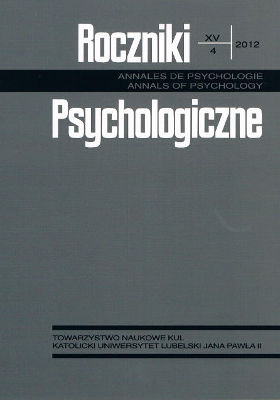Character types and self-concept
Abstract
The present study aims to answer the following question: What multidimensional relationships exist between character type and the structure of a person’s self-concept? We examined 174 students of theology using Z. Uchnast’s Action Styles Questionnaire (KSD) and W. H. Fitts’ Tennessee Self-Concept Scale (TSCS), translated and elaborated by Uchnast. The former method was used to define character types in the examined group. The letter method was used to describe the structure of the individual’s self-concept. Our analysis points to a positive self-concept among those who are oriented toward synergy with others (synergetic or cautious character type). By contrast, people with a negative self-concept are those oriented toward self-preservation (conformist or competitive character type). There is a characteristic dissimilarity in the configuration of TSCS scores between people whose character types are oriented toward synergy and people whose character types are oriented toward self-preservation. The existence of this dissimilarity indicates that the fundamental, qualitative difference between character types lies in their orientation either toward synergy with others or toward self-preservation.
References
Bulzak, A., Celińska Miszczuk, A. (2009). Style działania obronnego i synergicznego a psychologiczna jakość życia. W: Z. Uchnast (red.), Synergia w relacjach interpersonalnych i w organizacjach. Wybrane zagadnienia z psychologii kierowania (s. 93 116). Lublin–Nowy Sącz: TN KUL–WSB-NLU.
Celińska, A. (2007). Porównawcza analiza typologii osobowości C. G. Junga i W. Sterna (mps pracy doktorskiej, Archiwum KUL).
Celińska, A. (2008). Czy Williama Sterna koncepcja osoby ludzkiej jest wciąż inspirująca? W: A. Tokarz (red.), Wielkie teorie osobowości: koniec czy początek? (s. 151-165). Lublin–Nowy Sącz: TN KUL–WSB-NLU.
Cloninger, C. R. (1994a). Temperament and personality. Current Opinion in Neurobiology, 4, 2, 266-273.
Cloninger, C. R. (1994b). The genetic structure of personality and learning: A phylogenetic model. Clinical Genetics, 46, 1, 124-137.
Fitts, W. H. (1965). The Tennessee Self-Concept Scale: Manual. Los Angeles: Western Psychological Services.
Fitts, W. H., Roid, G. H. (1988). Tennessee Self-Concept Scale (TSCS): Revised manual. Los Angeles, CA: Western Psychological Services.
Hornowska, E. (2007). Wykorzystanie psychobiologicznej koncepcji osobowości C. R. Cloningera w obszarze uzależnień, http://www.narkomania.org.pl/czytelnia/25 (9.03.2009).
Łaguna, M. (1996). Budować obraz siebie. Lublin: RW KUL.
Maslow, A. H. (1971). The farther reaches of human nature. New York: The Viking Press.
Maslow, A. H. (1986). W stronę psychologii istnienia. Warszawa: IW PAX.
Maslow, A. H. (1990). Motywacja i osobowość. Warszawa: IW PAX.
Pastuszka, J. (1959). Charakter człowieka. Lublin: TN KUL.
Peterson, C., Park, N. (2007). Klasyfikacja i pomiar sił charakteru: implikacje dla praktyki. W: P. A. Linley, S. Joseph (red.), Psychologia pozytywna w praktyce (s. 263 283). Warszawa: Wydawnictwo Naukowe PWN.
Peterson, C., Seligman, M. E. P. (2004). Character strengths and virtues: A classification and handbook. Washington, DC: American Psychological Association.
Rogers, C. R. (1959). A theory of therapy, personality, and interpersonal relationships, as developed in the client-centered framework. W: S. Koch (red.), Psychology: A study of a science (s. 184 256). New York: McGraw-Hill.
Rogers, C. R. (1991). Terapia nastawiona na klienta. Grupy spotkaniowe. Wrocław: Thesaurus Press.
Stern, W. (1938). General psychology from the personalistic standpoint. New York: Macmillan.
Stern, W. (1950). Allgemeine Psychologie auf personalistischer Grundlage. Haag: Martinus Nijhoff.
Uchnast, Z. (1995). Tennessee Skala Obrazu Siebie (mps, Katedra Psychologii Ogólnej KUL).
Uchnast, Z. (2000). Style aktualizacji siebie. W: J. Makselon, B. J. Soiński (red.), Człowiek przełomu tysiącleci: problemy psychologiczne. Materiały z 31 Sympozjum Sekcji Psychologii Komisji Episkopatu ds. Nauki, Częstochowa 12 14.09.1999 (s. 139 152). Kraków: Wydawnictwo Naukowe PAT.
Uchnast, Z. (2007). Wybrane Skale Psychologicznej Jakości Życia (mps, Zakład Psychologii Ogólnej KUL).
Uchnast, Z. (2008a). Kwestionariusz Stylów Działania (mps, Katedra Psychologii Ogólnej KUL).
Uchnast, Z. (2008b). Typy charakteru i ich korelaty osobowościowe w wymiarze współdziałanie – zabezpieczanie się. W: B. J. Soiński (red.), Edukacja. Teologia i dialog: psychologiczne i pastoralne aspekty kapłaństwa (t. 5, s. 121 133). Poznań: Redakcja Wydawnictw Wydziału Teologicznego UAM.
Uchnast, Z. (2010). Samoaktualizacja czy aktualizacja siebie: spór o paradygmat ekspresji czy synergii. W: H. Wrona-Polańska, M. Ledzińska, G. Rudkowska (red.), W kręgu aksjologii i psychologii (s. 113 122). Kraków: Wydawnictwo Naukowe UP.
Copyright (c) 2012 Roczniki Psychologiczne

This work is licensed under a Creative Commons Attribution-NonCommercial-NoDerivatives 4.0 International License.


